Search alphabetically (by title):
- ALL
- #
- 0
- 1
- 2
- 3
- 4
- 5
- 6
- 7
- 8
- 9
- A
- B
- C
- D
- E
- F
- G
- H
- I
- J
- K
- L
- M
- N
- O
- P
- Q
- R
- S
- T
- U
- V
- W
- X
- Y
- Z
Rachel Williams
|
Filed under: Interpreting the Civil War: Texts and Contexts, Recent Releases, Religion, U.S. History
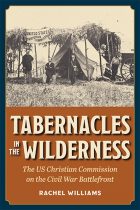
Tabernacles in the Wilderness discusses the work of the United States Christian Commission (USCC), a civilian relief agency established by northern evangelical Protestants to minister to Union troops during the American Civil War. USCC workers saw in the Civil War not only a wrathful judgment from God for the sins of the nation but an unparalleled opportunity to save the souls of US citizens and perfect the nation. Thus, the workers set about proselytizing and distributing material aid to Union soldiers with undaunted and righteous zeal.
Filed under: Interpreting the Civil War: Texts and Contexts, Recent Releases, Religion, U.S. History
Joseph L. Harsh
|
Filed under: Civil War Era
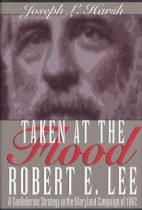
Complementing Confederate Tide Rising, which covers the origins of the Maryland campaign, Taken at the Flood is a detailed account of the military campaign itself. It focuses on military policy and strategy and the context necessary to understand that strategy. A fair appraisal of the campaign requires a full appraisal of the circumstances under which the two commanders, Robert E. Lee and George B. McClellan, labored. Harsh attempts to discover what they believed their responsibilities were and what they tried to accomplish; to evaluate the human and logistical resources at their disposal; and to determine what they knew and when the learned it.
Filed under: Civil War Era
Lester Goran
|
Filed under: Literature & Literary Criticism
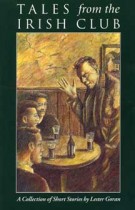
Tales from the Irish Club contains 11 wry accounts of an enclave of Irish Americans in Pittsburgh during and after World War II. In this first collection of short stories by Lester Goran are the often comic, sometimes tragic tales of Jack Lanahan, the transcendental artist who carves nothing but wooden roosters; Long Conall O’Brien, haunted by the ghosts of prostitutes he has known world-wide; Mrs. Pauline Conlon, famous as the woman who outlives three husbands—until she meets Sailor Kiernan; and the night an image of the Madonna appears on the wall of Local No. 9 of the Ancient Order of Hibernians.
Filed under: Literature & Literary Criticism
Donald Blume
|
Filed under: Civil War Era
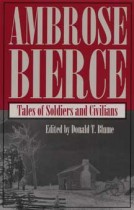
This revised edition of Ambrose Bierce’s 1892 collection of “Soldiers” and “Civilians” tales fills a void in American literature. A veteran of the Civil War and a journalist known for his integrity and biting satire, Ambrose Bierce was also a lively short-story writer of considerable depth and power. As San Francisco’s most famous journalist during the late-nineteenth and early-twentieth centuries, Bierce was hired by William Randolph Hearst to write a column for San Francisco Examiner, where his “Soldiers” and “Civilians” tales first appeared during the late 1880s.
Filed under: Civil War Era
John Morris
|
Filed under: Drama, Education, History, May 4 Resources, Regional Interest
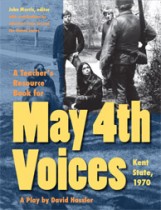
Created to supplement May 4th Voices, a play based on the 1970 tragedy, A Teacher’s Resource Book for May 4th Voices: Kent State, 1970 explains how real teachers in real classrooms have adapted the play to use in various pedagogical situations and levels of instruction. It offers lesson plans and background material for students and teachers, describing the national mood in 1970, the events in Southeast Asia that heightened tensions on U.S. campuses, and the culture of antiwar dissent both nationally and within the community of Kent, Ohio.
Tags: May 4th Voices: Kent State, voices, voices play Filed under: Drama, Education, History, May 4 Resources, Regional Interest
Verna Kale
|
Filed under: Hemingway Studies, Literature & Literary Criticism, Teaching Hemingway
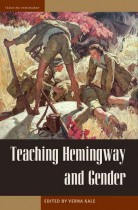
Ernest Hemingway’s place in American letters seems guaranteed: a winner of Nobel and Pulitzer prizes, Hemingway has long been a fixture in high school and college curricula. Just as influential as his famed economy of style and unflappable heroes, however, is his public persona. Hemingway helped create an image of a masculine ideal: sportsman, brawler, hard drinker, serial monogamist, and world traveler. Yet his iconicity has also worked against him. Because Hemingway is often dismissed by students and scholars alike for his perceived misogyny, instructors might find themselves wondering how to handle the impossibly over-determined author or even if they should include him on their syllabi at all.
Filed under: Hemingway Studies, Literature & Literary Criticism, Teaching Hemingway
Joseph Fruscione
|
Filed under: Hemingway Studies, Literature & Literary Criticism, Teaching Hemingway
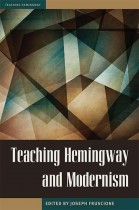
Teaching Hemingway and Modernism presents concrete, intertextual models for using Hemingway’s work effectively in various classroom settings, so students can understand the pertinent works, definitions, and types of avant-gardism that inflected his art. The fifteen teacher-scholars whose essays are included in the volume offer approaches that combine a focused individual treatment of Hemingway’s writing with clear links to the modernist era and offer meaningful assignments, prompts, and teaching tools.
Filed under: Hemingway Studies, Literature & Literary Criticism, Teaching Hemingway
Gary Edward Holcomb
|
Filed under: Hemingway Studies, Teaching Hemingway
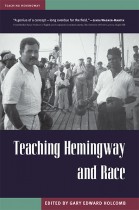
Teaching Hemingway and Race provides a practicable means for teaching the subject of race in Hemingway’s writing and related texts—from how to approach ethnic, nonwhite international, and tribal characters to how to teach difficult questions of racial representation. Rather than suggesting that Hemingway’s portrayals of cultural otherness are incidental to teaching and reading the texts, the volume brings them to the fore.
Filed under: Hemingway Studies, Teaching Hemingway
Kevin Maier
|
Filed under: Hemingway Studies, Nature, Teaching Hemingway
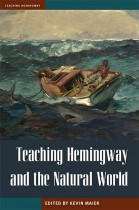
Ernest Hemingway is a writer we often associate with particular places and animals; Michigan’s Upper Peninsula, Spain’s countryside, East Africa’s game reserves, Cuba’s blue water, and Idaho’s sagebrush all come to mind. We can easily visualize the iconic images of Hemingway with fly rod bent by hefty trout, with bulls charging matadors, or of the famous author proudly posing with trophy lions, marlin, and a menagerie of Western American game animals.
Filed under: Hemingway Studies, Nature, Teaching Hemingway
Alex Vernon
|
Filed under: Hemingway Studies, Literature & Literary Criticism, Teaching Hemingway
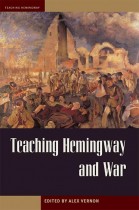
“I’ve been teaching Hemingway for more than two decades, and I can honestly say that this book will change the way that I introduce his work to my students.” —Stephen Trout, University of South Alabama
Filed under: Hemingway Studies, Literature & Literary Criticism, Teaching Hemingway











